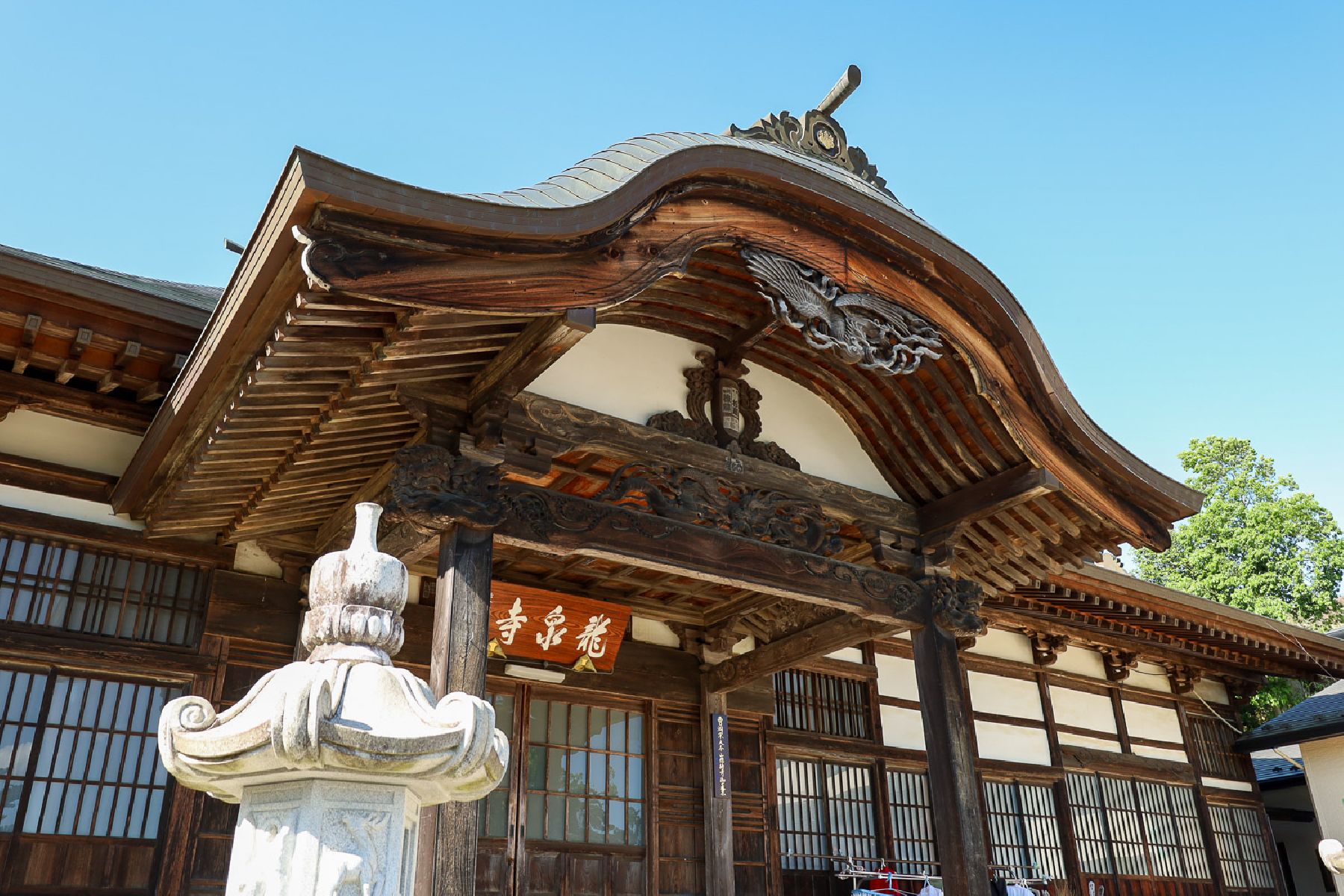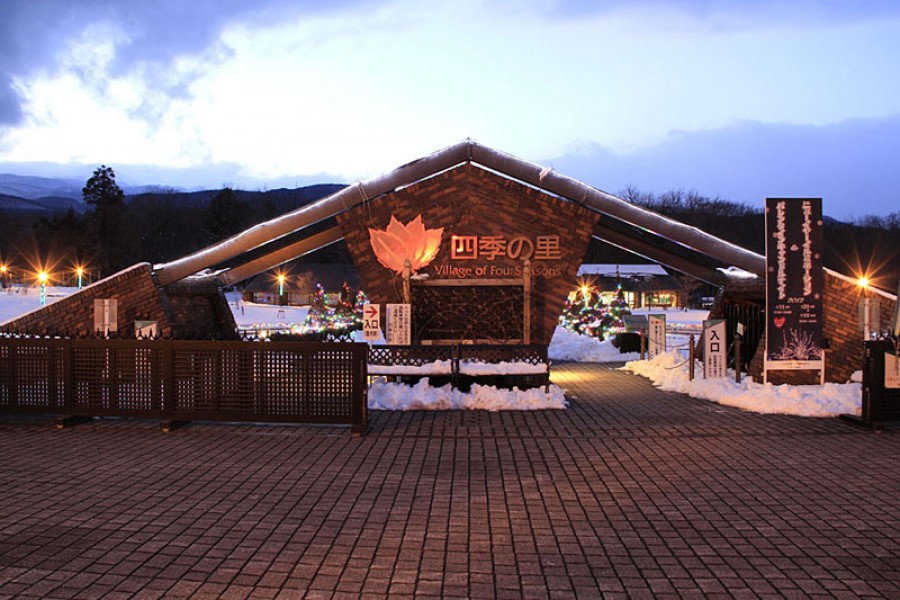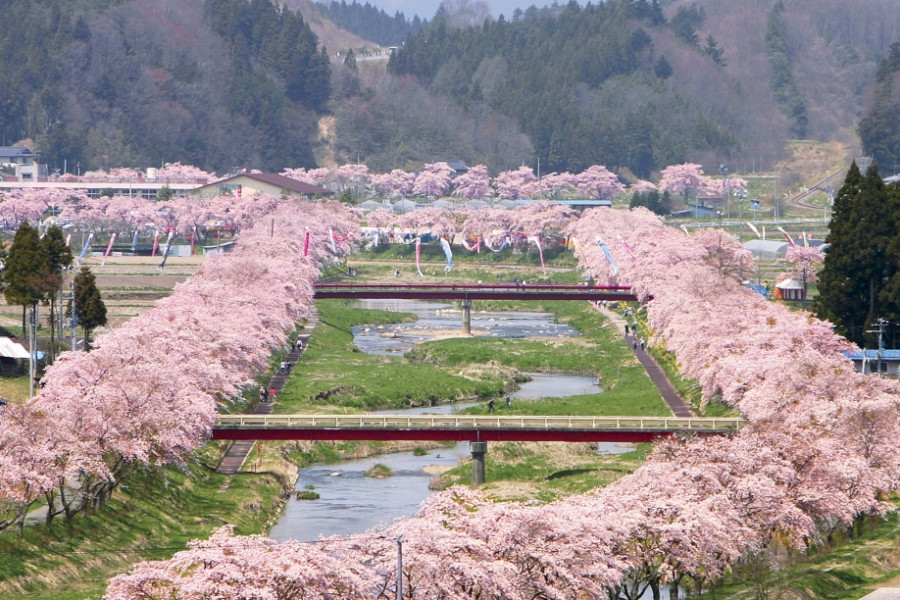
Noji Onsen
Noji Onsen is a beautifully scenic onsen resort in Adatara mountains. It is especially breathtaking when the outdoor baths, and their cloudy white waters, are surrounded by stunning snowy landscapes in winter.

These two weeping cherry trees are said to be the grandchildren of the great Miharu Takizakura weeping cherry tree in nearby Miharu Town. They bloom with fantastic pink flowers. When they are in full bloom, the trees are if a waterfall of blossoms is cascading from their branches. These trees are estimated to be around 170 years old. We recommend taking photographs from the bottom of the slope, so you can capture the pink of the blossoms, together with the blue of the sky, and yellow of the canola flowers.
| Website | http://www.city.nihonmatsu.lg.jp/page/page002711.html |
|---|---|
| Contact | Iwashiro Tourist Association (+81) 243-55-2111 iws.chiikishinko@city.nihonmatsu.lg.jp |
| Best Season |
|
| Parking | Available |
| Entrance Fee | Free |
| Access | 142 Obayashi, Higashiniidono, Nihonmatsu City, Fukushima Pref. 964-0301 View directions |
|---|---|
| Getting there | By Car: 30 min drive from Nihonmatsu I.C. exit off on the Tohoku Expressway; 30 min drive from Funehikimiharu I.C. exit off the Ban-etsu Expressway |

Noji Onsen is a beautifully scenic onsen resort in Adatara mountains. It is especially breathtaking when the outdoor baths, and their cloudy white waters, are surrounded by stunning snowy landscapes in winter.

Ryusenji Temple is the perfect place to refresh the mind and body during your trip to Fukushima Prefecture. Originally built in 1320, the temple underwent many name changes until being called Ryusenji. The beautiful main hall has not changed for about 300 years after being reconstructed due to a fire in 1758. Nowadays, the temple offers many interesting events and vistas to visitors.There are many sights to experience at Ryusenji. Inside the main hall of the temple, you can see a cloth bag containing the temple’s treasures and a palanquin-shaped box hanging from the ceiling. This important Cultural Property also contains many wooden statues and make for an impressive time amongst history.If you would like a more personal experience at Ryusenji Temple, why not try the Zazen meditation experience offered by the temple’s monks? Zazen is a short zen meditation experience and is offered at Ryusenji Temple on the first Sunday of every month, as well as the first and third Wednesdays of every month. Sit in silence and stillness for 20 minutes while you empty yourself of worldly thoughts and desires.It’s best to contact ahead of time to make reservations if you’d like to experience their Zazen, temple yoga, or calligraphy. The nature surrounding Ryusenji Temple and the calming halls of the temple will welcome you and give you peace of mind and spirit. So shed the busy angst of your life and let Ryusenji Temple offer you a serene experience.

Shiki no Sato (Village of Four Seasons) is a lawn-covered agricultural park of about 8 ha in size. There are western-inspired brick buildings in the center, which house a traditional crafts gallery. The gallery includes a glass workshop and kokeshi (traditional wooden doll) exhibit. You can learn to make blown glass, see kokeshi being made by local artisans, and try your hand at decorating a doll of your own. Shiki no Sato also has an ice cream shop offering seasonal ice creams made with the local fruits of Fukushima. In addition to ice cream, you can try a variety of locally-produced beers at the Shiki no Sato's beer hall. The seasonal flowers are a highlight of a visit to Shiki no Sato, which is loved by families and young couples alike. The summertime firework displays and the winter light-ups in the park are some of the most popular times to visit.

This tree is located on the grounds of a temple dedicated to the Buddhist deity Acala (known as Fudo Myoo in Japan), and is thus known locally as the Fudo Cherry Blossoms. The tree is about 350 years old and is considered to be a descendant of the Miharu Takizakura, a famous cherry tree located in nearby Miharu Town. Photography tip: Angle your camera so you capture both the cherry blossoms and the yellow canola flowers.

Mogi Station is a small, unassuming train stop that transforms drastically in spring. Every year around mid-April, the bank of over 30 cherry trees south of the station bursts into full bloom, turning the area into a picturesque array of pink, white and blue. The blossoms are illuminated at night once darkness falls, drawing visitors and photographers from across the region.Only the final train of the day, arriving at 21:30 from the direction of Miharu, pulls into platform two, with the background of the blooming cherry trees. For many photographers and train enthusiasts, this is the shot they visit to get. Despite its modest size, Mogi Station has quietly earned its place as one of the most photogenic, if lesser-known, hanami spots in the region.

Visitors looking for a cool and adventurous experience should consider visiting the Irimizu Limestone Cave (入水鍾乳洞) in Tamura City.Perhaps less known than the nearby Abukuma Cave, the Irimizu Limestone Cave offers visitors the opportunity to venture into its depths—the narrow cave is 900 m in total and is divided into three courses (A, B and C), each more extreme than the previous one.Visitors should bring adequate clothing and shoes, as the inside of the cave is wet and slippery with irregular rocky ground and gushing streams.Course A is the least extreme, and the way into the cave is lit, although there are puddles and wet spots, and you will need to duck in some places since there are short and narrow spots. Course A is 150 m long and takes approx. 30 minutes to complete.Courses B and C go through an area of the cave where there is less conditioning. Visitors have to walk while having water up to their knees and go through slippery and narrow gaps by candlelight or flashlight.Course B is 450 m and takes about 60 minutes to complete, while course C is 300 m and takes about 90 m to complete. Visitors hoping to undertake course C, the most difficult of the three, have to make a reservation before their visit, as the course can only be completed alongside an experienced guide. *Course C is not available and is not taking reservations as of May 2023.The temperature inside the cave is typically between 10 and 15 degrees regardless of the season.There are candles, rubber shoes, flashlights and other items available for renting at the entrance.Prices are as of March 2023.The cave has been designated as a National Natural Treasure, and it’s easy to see why. You’re bound to become a geology enthusiast after experiencing the charms of the cave.

There are 1,000 Yoshino cherry blossom trees planted along both sides of the Natsui River, giving the area the name of 'Natsui Senbon-Zakura', which translates as 'Natsui's 1000 cherry trees'. The view of the river stretching out in the distance is calming. The cherry blossoms actually line the river for a distance of 5 km. Natsui Senbon-Zakura offers good spots for taking pictures. Take a walk along the promenade near the banks of the Natsui River for some beautiful shots of the contrast between the glistening river and the cherry blossoms.

On an early November evening, visiting Autumn Sports Park is like stepping onto a movie set – you’re surrounded by towering, golden Ginkgo trees, lit up with bright, colorful lights. It is quite a sight to behold. The park is wonderful to visit any time of the year. It has a scented rose garden, stadiums and sports fields, as well as wide meadows to stroll and relax. At the park, you can also find the Fukushima City Minka-en Open-Air Museum.